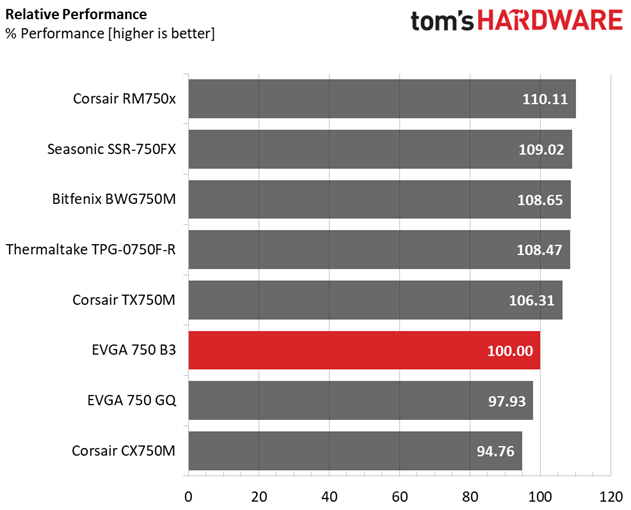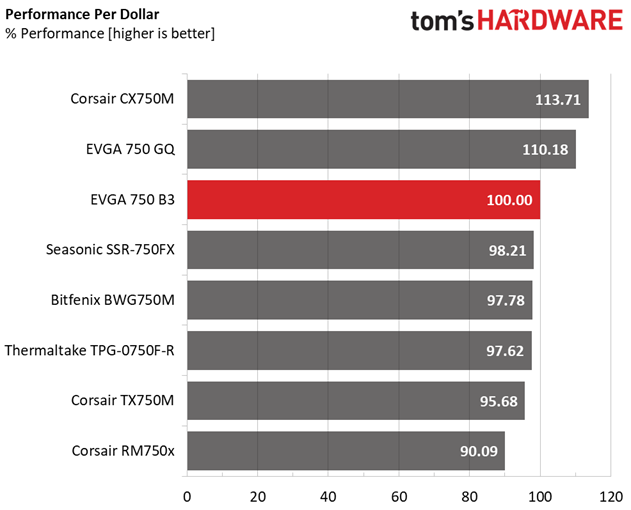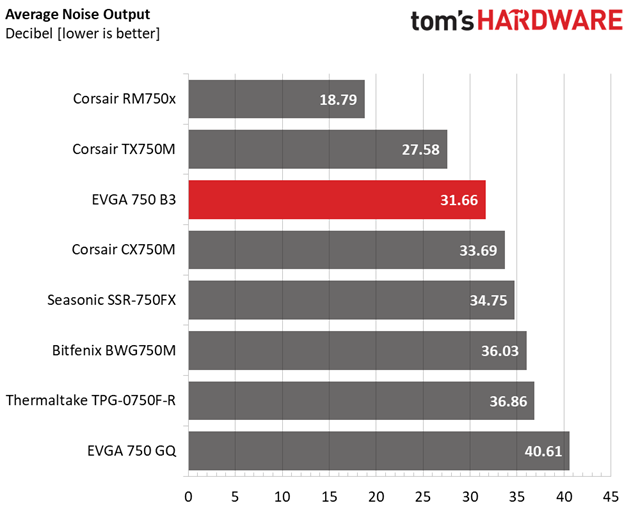EVGA 750 B3 PSU Review
Why you can trust Tom's Hardware
Performance, Value, Noise & Efficiency
Performance Rating
The following graph shows the 750 B3's total performance rating, comparing it to other units we have tested. To be more specific, the tested unit is shown as 100 percent, and every other unit's performance is shown relative to it.
The 750 B3 scores a much higher performance rating than the CX750M. However, Corsair's PSU survived all of our tests. And it sports better build quality.
Performance Per Dollar
The following chart may be the most interesting to many of you because it depicts the 750 B3's performance-per-dollar score. We looked up the current price of each PSU on popular online shops and used those prices and all relative performance numbers to calculate the index. If the specific unit wasn't available in the United States, we searched for it in popular European Union shops, converting the listed price to USD (without VAT). Note that all of the numbers in the following graph are normalized by the rated power of each PSU.
Corsair's CX750M easily takes the lead since it costs less (at least when this was written).
Noise Rating
The graph below depicts the cooling fan's average noise over the PSU's operating range, with an ambient temperature between 30°C and 32°C (86°F to 89.6°F).
EVGA's 750 B3 is a little bit quieter than the CX750M, which doesn't have a semi-passive mode and endures a higher minimum fan speed. The overall noise difference isn't large though.
Efficiency Rating
The following graph shows the average efficiency of the PSU throughout its operating range, with an ambient temperature close to 30°C.
Get Tom's Hardware's best news and in-depth reviews, straight to your inbox.
EVGA's and Corsair's efficiency levels are similar, even though the 750 B3 uses a more capable platform. Most likely, the 750 B3's fully modular design is to blame, compared to the CX750M's semi-modular implementation. Fixed cables have lower losses, especially under high loads, since their resistance is minimized compared to modular cables.
MORE: Best Power Supplies
MORE: How We Test Power Supplies
MORE: All Power Supply Content
Current page: Performance, Value, Noise & Efficiency
Prev Page Ripple Measurements Next Page Final Analysis
Aris Mpitziopoulos is a contributing editor at Tom's Hardware, covering PSUs.
-
Dark Lord of Tech Several complaints in the forums from builders , very disappointed with the B3 series.Reply -
logainofhades Yea, I will no longer recommend a B3 series PSU. Seasonic and Corsair's new CX450m-650m are better options right now.Reply -
SinxarKnights The solder quality between review samples and retail samples is pretty shady in of itself IMO.Reply -
10tacle The fact that EVGA hasn't even responded to the 450W B3 fail test that was back in August is highly disturbing in an of itself. It is inexcusable to just ignore a tech website's inquiry (and serious concerns) as to why a series of their products are failing. I know EVGA's customer support is top notch in the industry (I've had to use it), but their public/customer relations team needs an overhaul. If I were the CEO, I'd be calling for some heads and light a fire under some backsides to ride Super Flower hard for a fix.Reply -
maxwellmelon with out them identifying the failed component how can they say that the PSU not turning back on after a OPP is not intentional setup because it being shut down at 120% of load is about right like they said. It could be designed that way as a safety feature. and a way to sell more psu because when you try to RMA it they can say you overloaded it and is not covered. Operating above 750 watts is above the psu limits and having a one time OPP shut down is still technically having OPP on it.Reply -
Aris_Mp When a PSU is broken after OPP's triggering, it is not a feature but a problem. OPP along with the rest of the protections is there to protect the PSU in order not to break when a user goes wild with it.Reply -
Lutfij The third paragraph of the last page reminded me of what cars with all souped up aftermarket parts but a crappy driver often results with - disaster.Reply
EVGA Have recently come under flack on other forums as well and their response isn't, erm, admirable. Nice work with the review, Aris, keep it up! -
rtansey378 They must be having issues in the CS department. After dealing with them for an RMA I found their website to be down totally twice and fundamentally broken in important other areas during RMA submission. I was getting different answers from different people to basic questions and there were unreturned emails that led to other issues - it was kind of a nightmare overall that went on for a month. Even after being expedited to a manager of some type it wasn't much better. And their 2-3 advance RMA uses UPS ground so it is not 2-3 days at all. It routinely takes them 3 days to get the replacement into UPS' hands and then UPS takes their sweet time. People also use their expensive desktop PCs for work. I went through that twice as they sent the wrong unit back the first time.Reply
They charge a premium largely on their CS reputation. I guess they are now hoping people won't have to use it and learn otherwise. Being branded as a good guy in the CS is huge. Being branded as a bad guy is a death sentence. You'd think they would at least return major website emails and spin use some good old corporate spin. They won't even do that. Makes you wonder.
I hope they figure it out. But Im no longer going to pay their premium. If they have the cheaper product then I would still consider them. That will rarely be the case. They did some nice patented stuff with their GTX 1070/1080 revisions so maybe they are putting all their eggs in that basket. -
mlee 2500 Wow, I expect better from something EVGA puts their name on.Reply
THANK YOU tom's HARDWARE for performing objective tests on multiple samples to keep us informed and the vendors honest....
I seriously could have seen myself buying my next PSU based on EVGA's reputation alone. I won't make that that mistake now.



